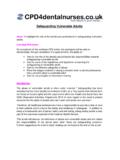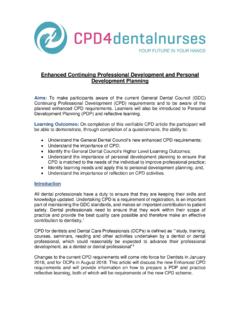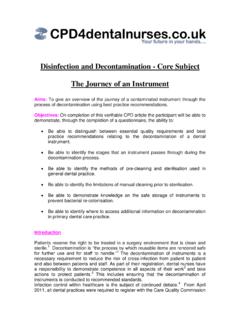Transcription of The Role of The Dental Care Professional During a …
1 The Role of The Dental Care Professional During a medical Emergency: General Dental Council Standards and The Management of The Collapsed Patient Using the ABCDE Approach Core Subject Part 4. Aims: To provide information on the General Dental Council (GDC) Standards for Dental Care Professionals on the training and management of medical emergencies in the Dental practice. To describe the principles of approaching the sick patient. To outline the Airway, Breathing, Circulation, Disability and Exposure approach for the care of the collapsed patient. Learning outcomes: On completion of this verifiable CPD article the participant will be able to demonstrate, through completion of a multiple choice questionnaire, the ability to: Locate and identify the GDC Standards for Dental Care Professionals (DCPs). on the management of medical emergencies within the Dental practice. Identify the principles of approaching the sick patient.
2 Recognise the signs of an acutely ill patient by using the ABCDE approach. Introduction To recap on the previous medical emergencies articles that you have completed as part of your Continuing Professional Development (CPD), the term emergency can be defined as a serious, unexpected, and often dangerous situation requiring immediate In dentistry this may mean a situation where a patient's life is in immediate danger. As discussed in previous medical emergencies articles, a study to review how frequently a medical emergency occurs in general Dental practice found that on average a practitioner may experience a medical emergency once in every 3-4. years2. The commonest problems encountered are vasovagal syncope (faints), hypoglycaemia, angina, seizures, choking, asthma and anaphylaxis 3. The causes and your role in the management of these emergencies have already been covered in previous medical emergency articles and will be updated each year on This article will outline the GDC and Resuscitation Council standards and guidance for the training and management of medical emergencies within the Dental practice.
3 The approach to the sick patient and the recognition of the acutely ill patient using the DR ABCDE approach will be described. The General Dental Council Standards for DCPs All DCPs should have received Standards Guidance booklets on the principles you should follow as a Dental Professional (fig: 1). You can also access the Standards for Dental Professionals from the GDC website which is available as a non-verifiable CPD link from the member's page of Fig: 1 GDC Standards booklet In the GDC Standards Guidance booklet The Principles of Teamworking', the GDC4. clearly state that: medical emergencies can happen at any time. There should be arrangements for at least two people to be available to deal with a medical emergency if treatment is to take place. All members of staff need to know their role if a patient collapses. All members of staff who might be involved in dealing with an emergency should be appropriately trained.
4 Dental teams should practise together regularly in simulated emergency situations (fig: 2). Fig:2 medical Emergency Training 5. The GDC publication Continuing Professional Development for Dental Care Professionals 6 states that DCPs are required to complete at least 10 hours of verifiable CPD on medical emergencies in every 5 year CPD cycle. Training Statements and Recommendations The Resuscitation Council3 stipulates that the early identification of the sick' patient should be encouraged. Being able to recognise a potential medical emergency by having the ability to recognise abnormal breathing, abnormal patient colour or an abnormal pulse rate, allows appropriate help to be summoned prior to the patient collapsing. Accurate documentation of a patient's medical history will allow those patients who may be at risk' to be identified prior to treatment. Know your Role Within the Dental surgery you are in a position to recognise from a patient's medical history those who may be more at risk' of collapse.
5 Take time to observe your patients for signs of distress or an abnormal colour or breathing pattern. Recommendations from the Resuscitation Council3 state that: 1) Staff should undergo regular training in the management of medical emergencies to a level appropriate to their expected clinical responsibilities. 2) Dental Practitioners and DCPs must be trained in cardiopulmonary resuscitation (CPR) so that in the event of a cardiac arrest they are able to: Recognise a cardiac arrest Summon help Start CPR according to resuscitation guidelines Give high flow rate oxygen (10-15 litres a minute) as soon as practicable. Provide other advance life support skills as appropriate and trained to do so. An AED (defibrillator) should be attached as soon as possible after collapse and defibrillation should be attempted if prompted to do so on the machine. 3) If the surgery treats children staff should be trained in child CPR.
6 4) Staff should update skills at least annually. 5) Equipment such as defibrillators (AEDs), self inflating bags and mask devices should be identified and a system put in place for special training. 6) All new members of staff should have an induction programme which incorporates resuscitation training. The DR ABCDE' Approach to the Sick Patient General Principles 1) When assessing and treating the patient follow the Airway, Breathing, Circulation, Disability and Exposure approach . 2) Use a systematic approach to care by treating life threatening problems as they are identified before moving to the next part of the assessment. 3) If there is further deterioration continually assess starting with the Airway. 4) Recognise and call for help early which may involve dialling 999 for an ambulance (fig 3). 5) Use all members of the Dental team and ensure that the team communicates effectively. 6) The aims of the initial treatment are to keep the patient alive and achieve some clinical improvement whilst waiting for help to arrive.
7 7) The ABCDE approach can be used irrespective of your training. Individual experience and training will determine which treatments you can give3. Fig:3 The DCP may be required to call for an ambulance7. First Steps The Resuscitation Council3 guidelines state that in an emergency situation the first steps are to: Stay calm and ensure that you and the staff are safe. Look at the patient generally to see if they look unwell'. If a patient is awake ask how they are. If the patient is unresponsive shake them and ask again. If they respond normally they have a clear airway and are breathing. Speak in short sentences may indicate breathing problems. Failure of the patient to respond suggests they are unwell. If they are not breathing and have no pulse of signs of life, start CPR. according to current resuscitation guidelines. These stages can be abbreviated to Danger Responsive The Resuscitation Council3 describes the ABCDE approach to the sick patient as follows: Airway (A).
8 Signs of airway obstruction: Paradoxical chest and abdominal movements ( see-saw' respirations). Use of the accessory muscles of respiration (for example the neck muscles). Central cyanosis (blue lips and tongue). If there is complete airway obstruction, there are no breath sounds from the mouth or nose. In partial airway obstruction an expiratory wheeze may indicate obstruction of the lower airways, gurgling may suggest liquid or a semi-solid foreign body is located in the upper air way and snoring may arise if the pharynx is partially occluded by the tongue. Treatment To open the airway tilt head, chin lift or jaw thrust (fig:4). Remove foreign visible bodies, debris or blood. Simple airway adjuncts may be considered (such as an oropharyngeal airway.). Use a mask with an oxygen reservoir. Give 10-15 litres of oxygen per minute. Fig: 4 Opening the airway by tilting the head8. Breathing (B).
9 Take into consideration that patients with Asthma are at risk and treat immediately. Look for signs of respiratory distress as outlined above. Count the respiratory rate, Adults 12-20 breaths per minute and children 20- 30 breaths per minute. If the respiration rate is high it may be a warning that the patient may deteriorate and further help may be required. Assess the depth and rhythm of each breath. Listen to sounds to assess airway obstruction as previously outlined. If a patient's depth or rate of breathing is of concern, or the patient is not breathing, use a bag and mask if you are trained to do so or a pocket mask with ventilation and oxygen and dial 999. Hyperventilation and panic attacks are quite common in the Dental surgery and mostly resolve with reassurance. Circulation (C). Faints are the most common cause of circulation problems in Dental practice. The patient will usually respond to lying flat and raising the legs.
10 Using the systematic ABCDE approach will ensure that other causes are not missed. Note the following: Colour of hands and fingers: are they blue, pink or pale? Assess limb temperature: cool or warm? Count the pulse rate. Weak pulses in a patient with decreased conscious level and slow capillary refill time may suggest low blood pressure (details on how to measure the capillary refill time can be found on the Resuscitation Council website). The patient should be laid down with the legs raised. If simple measures do not work an ambulance should be called. Cardiac chest pain typically presents as a heaviness, tightness or indigestion like discomfort in the chest. The pain or discomfort often radiates into the neck or throat, into one or both arms (more commonly the left) and into the back or stomach area. A patient with known angina may carry their own glycerol trinitrate spray or tablets which may resolve the problem.


